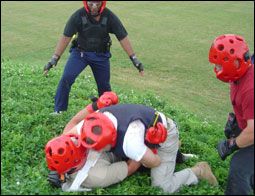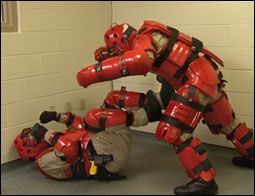There are many reasons for an officer in today’s society to learn and become proficient in ground-defense techniques and tactics.
 |
When you hear the term ground fighting, certain names come to mind: Ultimate Fighting Championship, Jujitsu, Judo, wrestling, Mixed Marital Arts, etc.
All of these systems are very effective, and in their own unique way meet the needs of correctional/law enforcement encounters. However, we need to remember that in any sporting event or fighting tournament there are always a few rules — Like no biting, eye gouging, kicking to the groin. Also, the fighters aren’t wearing any tight-fitting uniforms, ballistic vests, duty belt or firearm that will greatly limit the flexibility or the side the officer may have to work with.
Any ground-fighting system you learn needs to be effective in application and defensible in the courtroom. The system must also fit the needs of your administrations, and be supported by departmental polices.
Reasons you get to the ground!
 |
1. There’s the most obvious: an officer has attempted to gain control of a subject they are physically arresting, and the fight has been taken to the ground.
2. An officer is contaminated with OC and distance is not an option from the attacker, or when prying your eyes opens is impossible.
3. When the officer is injured or too exhausted to continue their fight on their feet. This is when a balanced, stable and protective ground positions needs to be assumed. This is the same balance needed when defending from a standing position.
It is important to remember when you are in a ground defense position to always provide cover to your head, heart, spinal (vertebrae area), and weapon. We need to understand the reality of a ground-fighting encounter, and ask ourselves a few important questions.
1. What is the goal of the subject when we go to the ground?
The primary goal of a subject who gets on top of an officer is to sit high up on their chest placing their knees high into the shoulder well of the officer. This is when the subject raises their elbows higher than the officer’s shoulders which opens up the airway and makes the chest cavity and ribs weaker. This places the officer in a vulnerable position because it’s difficult for the officer to have easy access to their firearm and it places officers in respiratory distress.
This also places the officer in a very compromising position: Do they use both hands to protect their face, or their firearm? Is it better to leave one exposed over the other?
Officer Action: Wiggle — this is a motion of rotating your hips from a 3-9 position to a 12-6 o’clock position.
2. What is the goal of the officer?
The primary goal of the officer while in a good, stable ground defense position is to keep the cutting edge of your palms higher than your eyebrows, tuck your chin in to protect your neck, and ensure your elbows are tightly brought into the chest area. This position will limit the subject’s ability to get high up on the chest. Make sure that both of your feet are bent at the knees and are flat on the ground.
Officer Action: Assume the ground guard position protecting your face, throat and weapon.
3. What are the officer’s use of force options?
Going to the ground is usually when all standing efforts have been exhausted. The use and practice of deadly force options need to be addressed and practiced by the officer. This should cover everything from their impact weapon, firearm, and even empty hand techniques.
Officer’s Action: Disengage, control, or deadly force if necessary. Remember to practice your force options.
4. At what stage is deadly force authorized?
The decision making process for any officer during a high risk situation or encounter is quick and often provides the officer with little to no time.
Officer Action: When the officer feels their life is in imminent danger. We refer to this as the “30 second rule,” which is the amount of time that 85% of the officers on your department would have the mental and physical endurance to identify and act on a survival level of proficiency, to survive a physical encounter.












